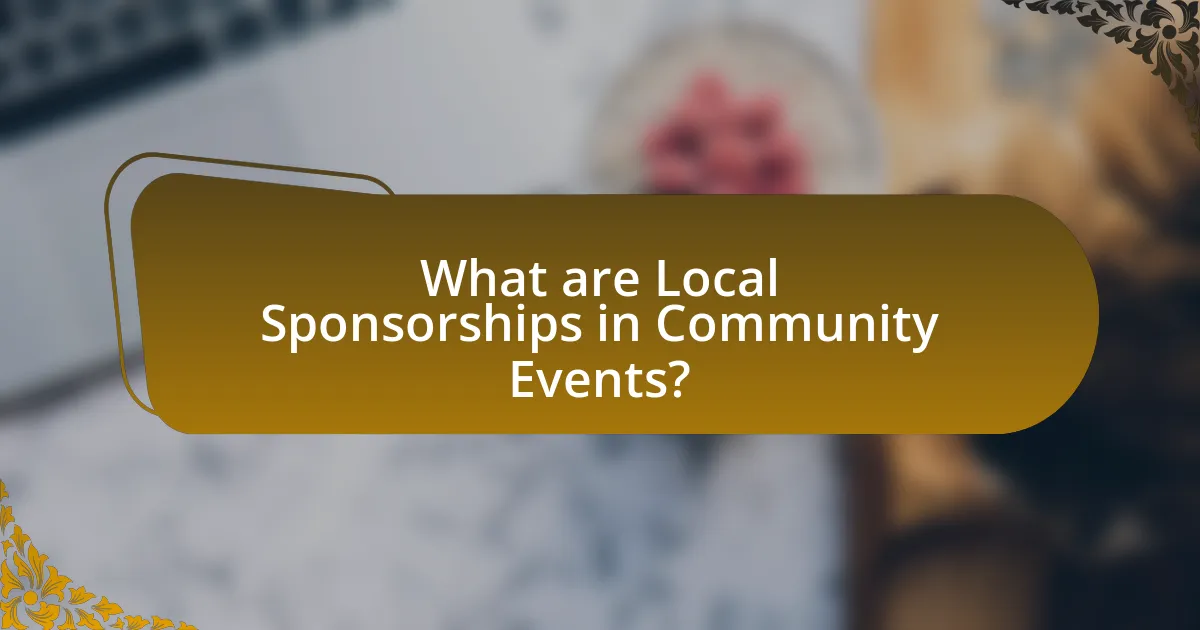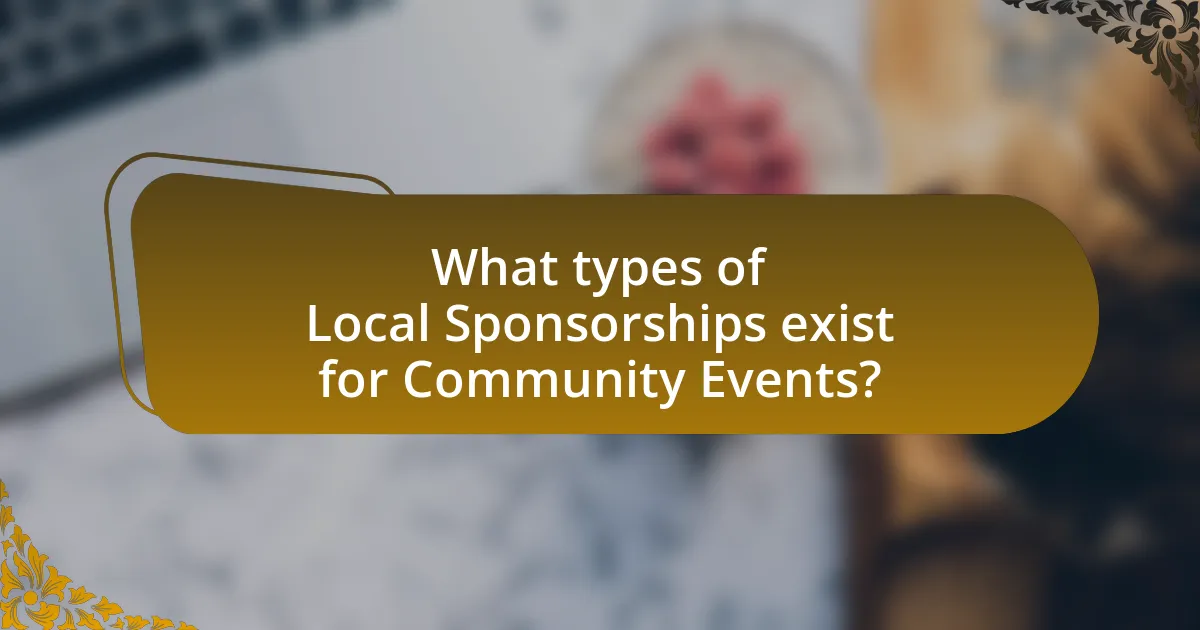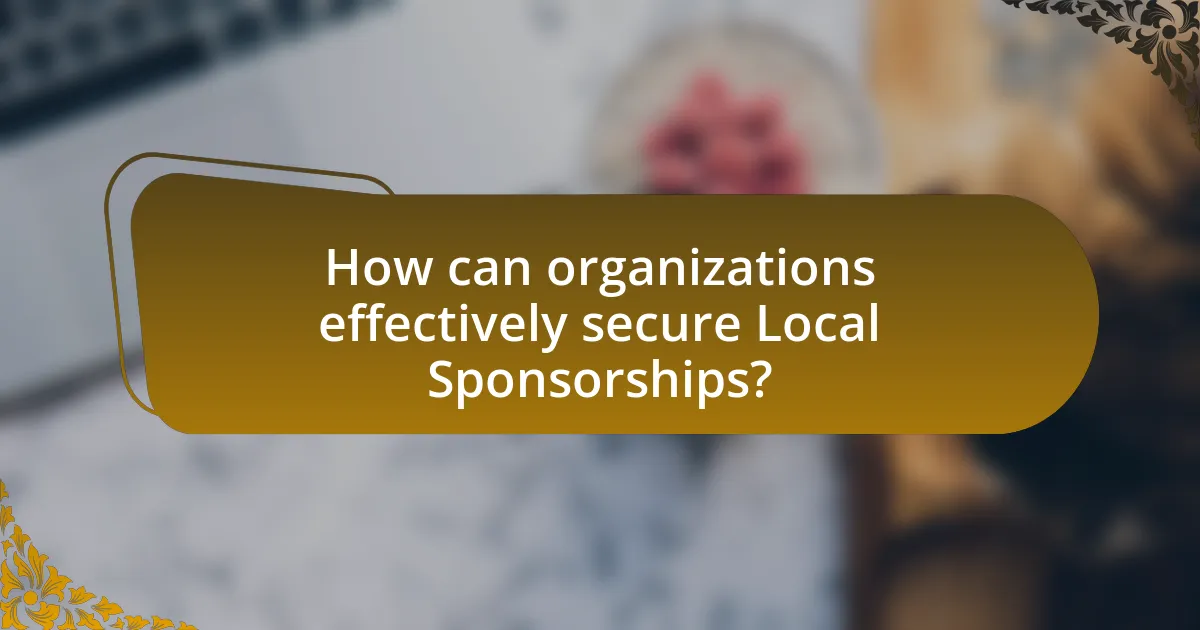Local sponsorships in community events refer to financial or in-kind contributions made by businesses or organizations to support local activities, enhancing community engagement and promoting local brands. These sponsorships play a vital role in the success of events by providing necessary funding, resources, and promotional assistance, which can lead to increased attendance and community involvement. The article explores the various types of local sponsorships, their impact on community events, and strategies for organizations to secure and leverage these partnerships effectively. It also addresses the challenges faced in obtaining sponsorships and best practices for maintaining long-term relationships with sponsors.

What are Local Sponsorships in Community Events?
Local sponsorships in community events are financial or in-kind contributions made by businesses or organizations to support local activities, such as festivals, sports events, or cultural gatherings. These sponsorships typically aim to enhance community engagement, promote local brands, and foster goodwill among residents. For instance, a local business may sponsor a community festival by providing funds for entertainment or donating products for giveaways, thereby increasing its visibility and strengthening its connection to the community.
How do Local Sponsorships function within Community Events?
Local sponsorships function within community events by providing financial support and resources in exchange for brand visibility and community engagement. Businesses contribute funds or services to help organize events, which in turn enhances their reputation and fosters goodwill among local residents. For instance, a study by the Community Foundation for Greater Atlanta found that 70% of local businesses reported increased customer loyalty after sponsoring community events. This symbiotic relationship benefits both the event organizers, who gain necessary funding, and the sponsors, who enhance their community presence and brand recognition.
What roles do sponsors play in the success of Community Events?
Sponsors play a crucial role in the success of community events by providing financial support, resources, and promotional assistance. Their funding enables organizers to cover costs such as venue rental, permits, and marketing, which are essential for executing a successful event. For instance, a study by the National Association of Counties found that events with sponsorships are 30% more likely to achieve their financial goals compared to those without. Additionally, sponsors often leverage their networks to promote the event, increasing attendance and community engagement. This symbiotic relationship not only enhances the event’s visibility but also fosters a sense of community by aligning local businesses with community interests.
How do sponsors contribute to the planning and execution of events?
Sponsors contribute to the planning and execution of events by providing financial support, resources, and promotional assistance. This financial backing enables event organizers to cover costs such as venue rental, marketing, and logistics, which are crucial for successful event execution. Additionally, sponsors often supply products or services that enhance the event experience, such as catering, technology, or entertainment. For instance, a local business sponsoring a community festival may offer food and beverages, thereby reducing expenses for the organizers while attracting attendees. Furthermore, sponsors leverage their marketing channels to promote the event, increasing visibility and attendance. This symbiotic relationship not only benefits the event but also enhances the sponsor’s brand recognition within the community.
Why are Local Sponsorships crucial for Community Events?
Local sponsorships are crucial for community events because they provide essential funding and resources that enable these events to take place. Local businesses often contribute financial support, goods, or services, which helps cover costs such as venue rental, permits, and promotional materials. According to a study by the National Association of Counties, community events that receive local sponsorships can increase attendance by up to 30%, demonstrating the direct impact of local support on event success. Additionally, local sponsorships foster community engagement and strengthen relationships between businesses and residents, creating a sense of belonging and shared purpose.
What benefits do Local Sponsorships provide to event organizers?
Local sponsorships provide event organizers with essential financial support, enhancing the overall budget and enabling the execution of higher-quality events. This financial backing allows organizers to allocate resources towards better venues, marketing efforts, and entertainment options, ultimately improving the attendee experience. Additionally, local sponsorships foster community engagement, as sponsors often have established relationships within the community, which can lead to increased attendance and participation. According to a study by the Event Marketing Institute, 74% of event attendees are more likely to engage with brands that support local events, demonstrating the effectiveness of local sponsorships in driving community involvement and brand loyalty.
How do Local Sponsorships enhance community engagement?
Local sponsorships enhance community engagement by providing financial support and resources for community events, which fosters participation and connection among residents. When local businesses sponsor events, they create opportunities for community members to gather, interact, and build relationships, thereby strengthening social ties. For instance, a study by the National Endowment for the Arts found that community events funded by local sponsors increase attendance and participation rates, leading to a more vibrant community atmosphere. This financial backing not only enables the organization of events but also encourages local pride and ownership, as residents see their community supported by local businesses.

What types of Local Sponsorships exist for Community Events?
Local sponsorships for community events typically include cash sponsorships, in-kind donations, promotional partnerships, and media sponsorships. Cash sponsorships involve direct financial contributions to support event costs, while in-kind donations provide goods or services instead of money, such as food, equipment, or venue space. Promotional partnerships allow businesses to gain visibility through event marketing, often in exchange for their support. Media sponsorships involve local media outlets providing advertising or coverage in return for brand exposure. These sponsorship types are essential for enhancing community engagement and ensuring the success of local events.
How do different sponsorship levels impact Community Events?
Different sponsorship levels significantly impact community events by determining the scale, reach, and quality of the event. Higher sponsorship levels typically provide more financial resources, enabling organizers to enhance event features such as venue quality, marketing efforts, and entertainment options. For instance, a study by the National Association of Sponsorships found that events with premium sponsors can attract 30% more attendees compared to those with lower sponsorship levels, demonstrating a direct correlation between sponsorship investment and event success. Additionally, varying sponsorship levels can influence community engagement; events with diverse sponsorship tiers often foster a broader range of local business participation, enhancing community ties and support.
What are the common tiers of sponsorship available?
The common tiers of sponsorship available typically include title sponsorship, presenting sponsorship, gold sponsorship, silver sponsorship, and bronze sponsorship. Title sponsorship represents the highest level of investment, often featuring the sponsor’s name prominently in event branding. Presenting sponsorship usually involves significant visibility and branding opportunities, but at a slightly lower investment than title sponsorship. Gold, silver, and bronze sponsorships provide varying levels of exposure and benefits, with gold offering substantial visibility, silver providing moderate exposure, and bronze being the entry-level tier with basic benefits. These tiers allow organizations to choose a sponsorship level that aligns with their marketing goals and budget.
How do benefits vary across different sponsorship levels?
Benefits vary significantly across different sponsorship levels, with higher tiers typically offering more extensive exposure and engagement opportunities. For instance, a platinum sponsorship may include prominent logo placement on all event materials, exclusive access to VIP areas, and opportunities for direct interaction with attendees, while a bronze sponsorship might only provide basic logo visibility and limited promotional benefits. This tiered structure allows sponsors to choose a level that aligns with their marketing goals and budget, ensuring that the benefits received correspond to their investment.
What are the key factors that attract sponsors to Community Events?
Key factors that attract sponsors to community events include audience reach, brand alignment, and community engagement. Sponsors are drawn to events that provide access to a targeted demographic, allowing them to effectively promote their products or services. For instance, a local business may sponsor a community festival to connect with families in the area, enhancing brand visibility. Additionally, alignment with the event’s values and mission is crucial; sponsors prefer events that resonate with their brand identity, ensuring a cohesive message. Community engagement is also significant, as sponsors seek opportunities to build goodwill and strengthen relationships with local consumers. According to a study by IEG, 70% of sponsors believe that community involvement enhances their brand image, demonstrating the importance of these factors in attracting sponsorships.
How does community visibility influence sponsorship decisions?
Community visibility significantly influences sponsorship decisions by enhancing the perceived value of the sponsorship opportunity. When a community is highly visible, it attracts more attention from potential sponsors, as they seek to align their brand with well-recognized and engaged audiences. For instance, a study by the Sponsorship Research International found that 70% of sponsors prioritize community engagement metrics when deciding on sponsorship investments, indicating that visibility directly correlates with sponsorship attractiveness. This visibility not only increases the likelihood of sponsorship but also allows sponsors to leverage community goodwill, thereby enhancing their brand image and customer loyalty.
What role does brand alignment play in attracting sponsors?
Brand alignment plays a crucial role in attracting sponsors by ensuring that the values and goals of both the event and the sponsoring brand are compatible. When a community event aligns with a sponsor’s brand identity, it enhances the likelihood of a partnership, as sponsors seek to associate with events that reflect their own mission and resonate with their target audience. For instance, a health-focused event would attract sponsors from the wellness industry, as their shared commitment to health and community engagement creates a mutually beneficial relationship. This alignment not only increases the appeal of the event to potential sponsors but also fosters trust and credibility, making it more likely for sponsors to invest in the event.

How can organizations effectively secure Local Sponsorships?
Organizations can effectively secure local sponsorships by building strong relationships with local businesses and demonstrating mutual benefits. Establishing connections through networking events, community meetings, and direct outreach allows organizations to identify potential sponsors who align with their mission. Presenting a clear value proposition, such as increased brand visibility and community goodwill, can persuade businesses to invest. Additionally, showcasing past successful sponsorships and providing data on audience reach can enhance credibility. According to a study by the Sponsorship Research International, 70% of sponsors reported that community engagement significantly influenced their decision to sponsor local events, highlighting the importance of aligning sponsorship opportunities with community interests.
What strategies can be employed to approach potential sponsors?
To approach potential sponsors effectively, organizations should utilize targeted research, personalized outreach, and value proposition development. Targeted research involves identifying sponsors whose values align with the event’s mission, ensuring a mutually beneficial partnership. Personalized outreach includes crafting tailored communication that highlights specific benefits for the sponsor, such as brand visibility and community engagement. Developing a compelling value proposition is crucial; it should clearly articulate how the sponsorship will enhance the sponsor’s brand image and connect them with the local community. These strategies are supported by studies indicating that personalized marketing increases engagement rates by up to 50%, demonstrating the effectiveness of tailored approaches in securing sponsorships.
How can organizations create compelling sponsorship proposals?
Organizations can create compelling sponsorship proposals by clearly defining the mutual benefits for both the sponsor and the event. A well-structured proposal should include specific details about the event, target audience demographics, and the potential reach and visibility for the sponsor. For instance, highlighting past successful sponsorships can demonstrate the effectiveness of the partnership, as seen in studies showing that local sponsorships can increase brand awareness by up to 70%. Additionally, including tailored sponsorship packages that outline various levels of investment and corresponding benefits can attract a wider range of sponsors. By focusing on measurable outcomes and aligning the proposal with the sponsor’s marketing goals, organizations can significantly enhance the appeal of their sponsorship proposals.
What are the best practices for building long-term sponsor relationships?
The best practices for building long-term sponsor relationships include consistent communication, mutual benefit, and demonstrating value. Consistent communication fosters trust and keeps sponsors informed about event developments and outcomes. Establishing mutual benefit ensures that both the sponsor and the event organizers achieve their goals, such as increased visibility for the sponsor and community engagement for the organizers. Demonstrating value through measurable results, such as attendance figures or social media engagement, reinforces the partnership’s effectiveness. Research indicates that organizations that maintain regular updates and showcase successful outcomes are more likely to retain sponsors over time, as evidenced by a study from the Association of Fundraising Professionals, which found that 70% of sponsors prefer ongoing relationships with organizations that provide clear metrics of success.
What challenges do organizations face in obtaining Local Sponsorships?
Organizations face several challenges in obtaining local sponsorships, primarily including limited budgets, competition for sponsorships, and lack of awareness among potential sponsors. Limited budgets restrict organizations from offering attractive sponsorship packages, making it difficult to entice local businesses. Additionally, competition arises as multiple organizations often seek the same local sponsors, leading to a crowded marketplace where sponsors may feel overwhelmed. Furthermore, many potential sponsors may lack awareness of the benefits of local sponsorships, resulting in missed opportunities for collaboration. These challenges highlight the complexities organizations must navigate to secure local sponsorships effectively.
How can organizations overcome common obstacles in sponsorship acquisition?
Organizations can overcome common obstacles in sponsorship acquisition by developing tailored proposals that align with potential sponsors’ goals and values. This approach ensures that the sponsorship opportunity resonates with the sponsor’s brand identity and marketing objectives. Research indicates that 70% of sponsors prioritize alignment with their brand when considering sponsorship opportunities, highlighting the importance of a customized approach. Additionally, organizations should leverage existing relationships and networks to facilitate introductions and build trust, as 65% of successful sponsorships stem from personal connections. By focusing on these strategies, organizations can effectively navigate challenges in securing sponsorships.
What are the potential pitfalls to avoid when seeking sponsorships?
When seeking sponsorships, potential pitfalls to avoid include failing to align the sponsor’s values with the event’s mission, which can lead to a mismatch in audience engagement. Additionally, not conducting thorough research on potential sponsors may result in targeting companies that do not have a vested interest in the community or event type. Poor communication regarding expectations and benefits can also create misunderstandings, leading to dissatisfaction on both sides. Lastly, neglecting to provide measurable outcomes or reports on the sponsorship’s impact can deter future partnerships, as sponsors often seek tangible results to justify their investment.
What are the best practices for leveraging Local Sponsorships in Community Events?
The best practices for leveraging local sponsorships in community events include establishing clear objectives, selecting relevant sponsors, and fostering strong relationships. Establishing clear objectives ensures that both the event organizers and sponsors understand the goals, such as brand visibility or community engagement. Selecting relevant sponsors who align with the event’s mission enhances authenticity and audience connection; for instance, a local health fair may benefit from partnerships with local healthcare providers. Fostering strong relationships through regular communication and collaboration can lead to long-term partnerships, as evidenced by studies showing that businesses with community ties experience increased customer loyalty and brand recognition.
How can organizations maximize the impact of their sponsors during events?
Organizations can maximize the impact of their sponsors during events by strategically integrating sponsor branding into all event aspects, ensuring visibility and engagement. This can be achieved through prominent logo placements on promotional materials, signage, and digital platforms, which increases brand recognition. Additionally, organizations should create interactive opportunities for sponsors, such as booths or speaking slots, allowing sponsors to engage directly with attendees. Research indicates that events with high sponsor engagement can lead to a 30% increase in brand recall among participants. By fostering a collaborative environment where sponsors feel valued and involved, organizations can enhance the overall effectiveness of sponsorships, driving mutual benefits for both parties.
What follow-up actions should be taken post-event to maintain sponsor relationships?
Post-event, organizations should send personalized thank-you notes to sponsors to express gratitude for their support. This action reinforces the relationship and acknowledges the sponsor’s contribution, which is crucial for future collaborations. Additionally, sharing event outcomes, such as attendance figures and media coverage, demonstrates the value the sponsor received from their investment. Providing a detailed report on the event’s success, including metrics that highlight the sponsor’s visibility, further solidifies the partnership. Engaging sponsors in post-event surveys allows organizations to gather feedback, showing that their opinions are valued and considered for future events. These follow-up actions are essential for maintaining strong sponsor relationships and ensuring ongoing support for community events.
